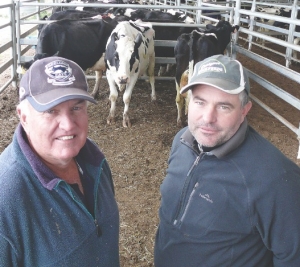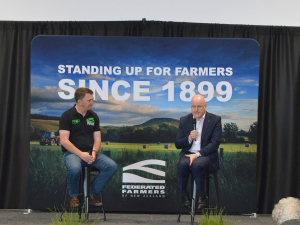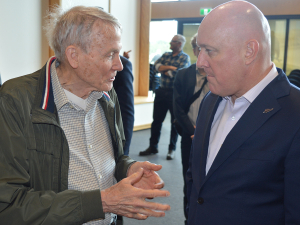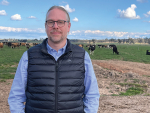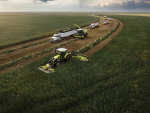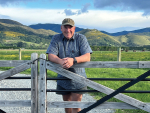Farmers are saying they believe the worst of the tough season is behind them and that a higher opening price and a mild but relatively wet winter should set the springboard for a better season.
Some winter pasture growth has eased fodder shortages and contributed to the more buoyant outlook.
Cow prices are also moving up and are being pushed by more enquiries from interested buyers.
While there are mixed outcomes and some farms are still struggling with equity, debt and feed issues, others are starting to build herds in anticipation of improved conditions in spring.
There is also a move back to dairy in some regions as farmers and investors see opportunities to capitalise on lower land prices.
United Dairyfarmers of Victoria President Kerry Callow says most dairy farmers are starting to see a light at the end of the tunnel and were looking forward to a brighter season.
Callow recently toured farms along the Princes Highway in south-west Victoria and found that while farmers were still concerned about economic pressures and apprehensive about spring weather, there was generally a more optimistic outlook than a few months ago.
“By far the most serious concerns expressed to us came from the south-west because of the long hot summer, economic conditions and feed shortages,” she says.
“In the north it’s still economically tight but most have been learning over the past 10 years to better manage risk and are coping okay.
“The economic conditions are also tight in Gippsland and because of the feed situation production has been quite a bit lower but it is picking up and farmers are generally feeling more comfortable with the milder winter.”
Callow says there were still pockets of farmers across the state having difficulty managing the conditions.
“The overarching problem is still the economic hit they’ve been through which dents the confidence of the industry. However, quite a few farmers are sick of the negativity.”
Callow says that production levels have been lower than last year due to the feed shortage and economic conditions which had negated the effect of the milk price rise, “but the general feeling is that with the early price rise and the weather, as long as we get good rain in August and autumn, things are looking up.”
Callow added that the industry would learn from the tough season and develop better risk management practices. “Volatility is always going to be with us and we have to learn to better manager those risks,” she says.
Rural financial counsellor for the Kerang area in northern Victoria, Dominic Baxter, agreed that farmer sentiment was picking up.
“The new milk price is a welcome lift and the season is encouraging,” Baxter says.
“It has probably been the best winter rainfall for a few years. Fodder is growing a bit which has eased the feed shortages.”
Baxter says some farmers were considering applying for the Federal Government’s concessional loan scheme and were still hurting from last year’s low milk prices and tough season. “But it’s a mixed bag…there is also a good deal of optimism and some talk of re-starting some former dairies,” he said.
Baxter’s counterpart in south-west Victoria, Vince Thorne, says farmers seemed to be “past the worst of it”.
“Farmers are sensing that the season is going their way which they look at as a positive,” says Thorne.
“Milk production is still lower than last year but it is picking up and they see the rain and look forward to a good spring.”
Thorne says more hay had been released in the area; farmers had taken advantage of alternate feed options and were growing more pastures due to the mild conditions.
“A lot of farmers still have problems with trade debts and lower equity, but they are in a better situation looking forward than they were a few months ago,” he says.
Thorne added that not many dairy farmers were taking up the Federal Government’s concessional loan scheme as it didn’t address their trade and working capital debt issues and because they wanted to keep a close relationship with their primary bank.
Gippsland-based consultant John Mulvany from OnFarm Consulting says the general feeling was of relief that there are some positive signs with the milk price finally getting into a range where there could be a reasonable return on assets and effort for dairy business operators.
However, he added that in southern Victoria there would be “a lot of catch up” for many dairy farmers.
Mulvany says any descriptor of a ‘typical’ dairy farm in 2012-13 was nonsense. “Some farms have returned very substantial losses while others have taxable profits despite harsh seasonal conditions,” he says. “The same issues of cost control, debt management and season mean that some will barely survive while others will thrive.”
Mulvany says that for any growth to occur in the industry there needed to be two or three years of milk price in excess of $A5.80/kgMS “which is unlikely given historic volatility”.
South Australian Dairyfarmers’ Association president David Basham says farmers had more confidence than a few months ago but many were still carrying a lot of debt.
“There have been some mild feed shortages in certain areas but it was pleasing that hay exporters made hay available at reasonable prices to fill the gap,” Basham says.
“It has been a mild winter generally with good rainfall and the crop outlook is also looking good which gives us more confidence.”





